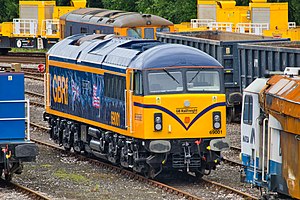| British Rail Class 69 | |||||||||||||||||||||||||||||||||||||||||||||||||
|---|---|---|---|---|---|---|---|---|---|---|---|---|---|---|---|---|---|---|---|---|---|---|---|---|---|---|---|---|---|---|---|---|---|---|---|---|---|---|---|---|---|---|---|---|---|---|---|---|---|
 The first-built Class 69 locomotive at Tonbridge West Yard | |||||||||||||||||||||||||||||||||||||||||||||||||
| |||||||||||||||||||||||||||||||||||||||||||||||||
| |||||||||||||||||||||||||||||||||||||||||||||||||
| |||||||||||||||||||||||||||||||||||||||||||||||||
| |||||||||||||||||||||||||||||||||||||||||||||||||
The British Rail Class 69 is a class of diesel locomotives which are converted from Class 56 locomotives. The conversion work is performed by Progress Rail at their workshop in Longport.
The Class 69 was developed to fulfil the needs of the rail freight operator GB Railfreight (GBRf), which was unable to purchase additional Class 66 diesel locomotives yet sought more capacity in a similar performance band. The conversion of surplus Class 56s, which were available in sufficient quantity and in good enough condition to make the class a good candidate for the project, proved to be a desirable option, being more affordable than new build locomotives while achieving similar performance to the Class 66 post-conversion. Many of the new systems installed are similar, or identical, to those present on the Class 66, including its EMD 710 powerplant and associated control systems; this was a deliberate choice in order to maximise the performance similarities. Retained elements were refurbished to an as-new condition.
- ^ a b c d e f g h i j Vehicle Diagram Book No. 100 for Main Line Diesel Locomotives (PDF). Derby: Mechanical & Electrical Engineering Department, British Railways Board. December 1981. 56-aA (in work p. 113). Retrieved 5 February 2023 – via Barrowmore MRG.
- ^ a b c d e f Clinnick, Richard (30 December 2020). "Exclusive: The GB Railfreight Class 69 project explained". Rail Magazine. Peterborough: Bauer Consumer Media. Retrieved 5 February 2023.
- ^ a b Walmsley, Ian (21 January 2021). "Shedding the Grid". Modern Railways. Stamford: Key Publishing. Retrieved 5 February 2023.
- ^ Fletcher, Steven (26 May 2021). "The Railways (Interoperability) Regulations 2011, as amended - Class 69 Sub-system (GBRf Class 69 Repower)" (PDF). Letter to Robert Tiller (GB Railfreight Ltd). London: Office of Rail and Road. UK/51/2021/0039. Retrieved 5 February 2023.
Cite error: There are <ref group=note> tags on this page, but the references will not show without a {{reflist|group=note}} template (see the help page).
